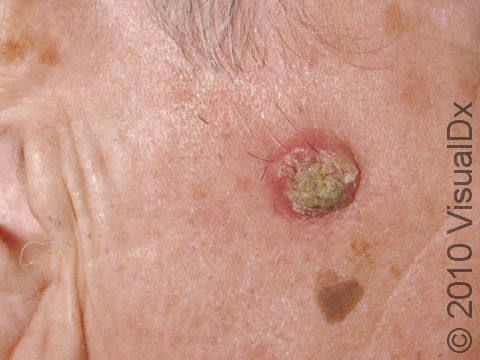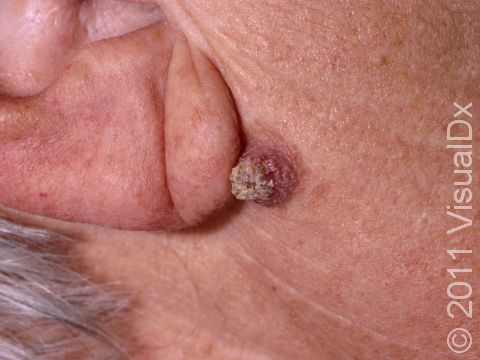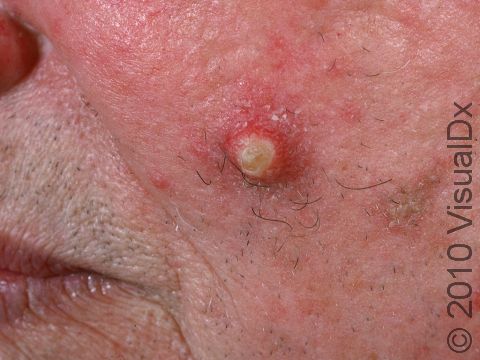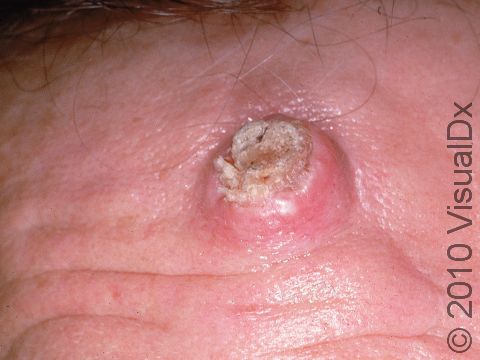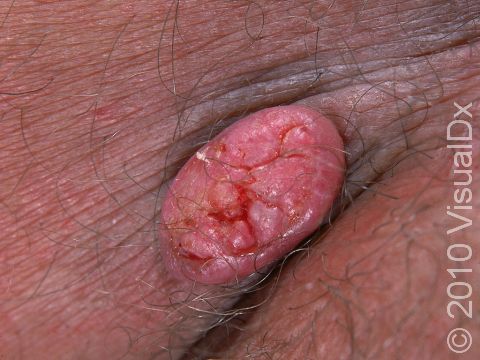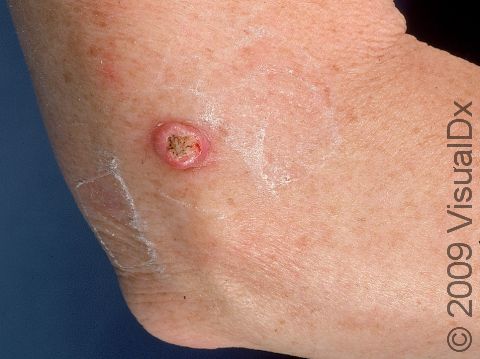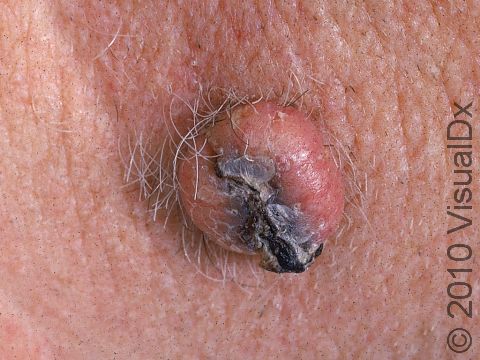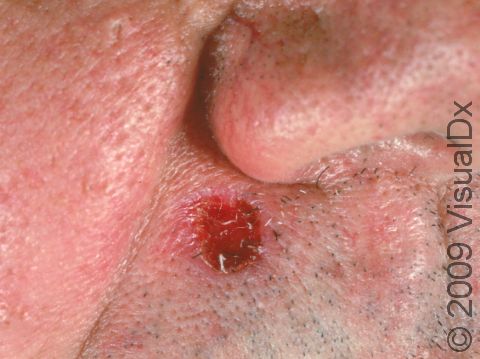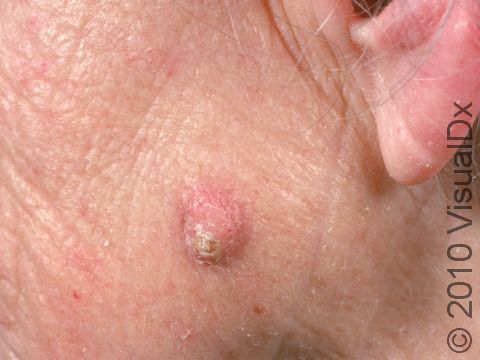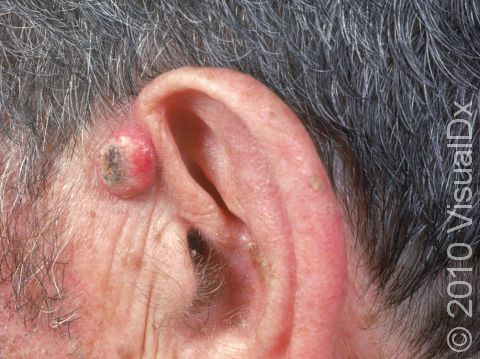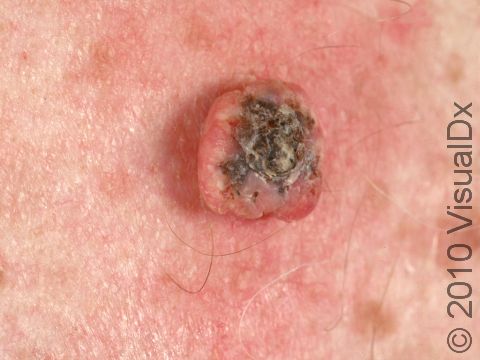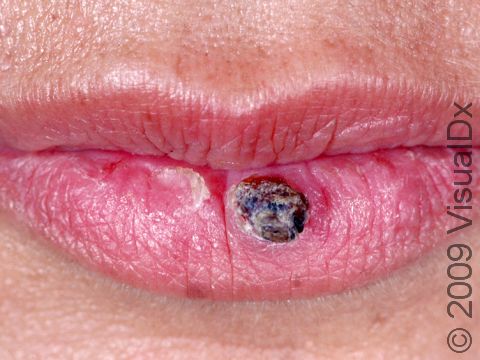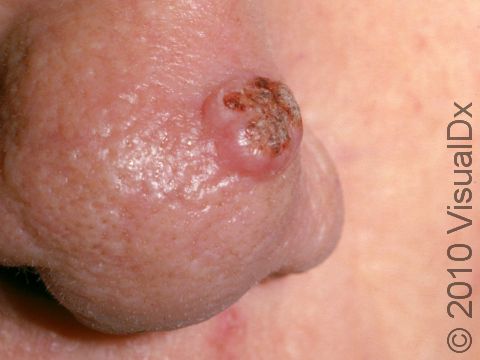Keratoacanthoma
Keratoacanthoma (KA) is a rapidly growing skin cancer usually appearing as a volcano-like bump on the sun-exposed skin of middle-aged and elderly individuals. Many scientists consider keratoacanthoma to be a less serious form of squamous cell carcinoma. Most keratoacanthoma cause only minimal skin destruction, but a few behave more aggressively and can spread to lymph nodes.
Who's At Risk?
Keratoacanthoma is most commonly seen in elderly, light-skinned people with a history of sun exposure.
Risk factors for the development of keratoacanthoma include:
- Age over 50
- Fair skin, light hair, or light eyes
- Male
- Chronic exposure to sunlight or other ultraviolet light
- Exposure to certain chemicals, such as tar
- Exposure to radiation, such as X-ray treatment for internal cancers
- Long-term suppression of the immune system, such as organ transplant recipients
- Long-term presence of scars, such as from a gasoline burn
- Chronic ulcers
- Presence of particular strains of the wart virus (human papillomavirus)
- Previous skin cancer
Signs & Symptoms
The most common locations for keratoacanthoma include:
- Center of the face
- Backs of hands
- Forearms
- Ears
- Scalp
- Lower legs, especially in women
A keratoacanthoma appears and grows rapidly over the course of 2–6 weeks. Starting as a small, pimple-like lesion, a keratoacanthoma typically develops into a dome-shaped, skin-colored nodule with a central depression filled with keratin (the major protein found in hair, skin, and nails). Keratoacanthoma usually range in size from 1–2.5 cm.
In rare cases, multiple keratoacanthomas may develop as part of a larger group of symptoms (syndrome).
Most keratoacanthoma are painless, though some may be itchy. Depending on the site of involvement, keratoacanthoma may interfere with normal function of the affected area.
Self-Care Guidelines
There are no effective self-care treatments for keratoacanthoma. Preventing sun damage is crucial to avoiding the development of keratoacanthoma:
- Avoid ultraviolet (UV) light exposure from natural sunlight or from artificial tanning devices.
- Wear broad-spectrum sunscreens (blocking both UVA and UVB) with SPF 30 or higher, reapplying frequently.
- Wear wide-brimmed hats and long-sleeved shirts.
- Stay out of the sun in the middle of the day (between 10:00 AM and 3:00 PM).
Treatments
If left untreated, most keratoacanthoma spontaneously disappear (resolve) within 6 months, leaving a depressed scar. However, they may cause significant damage to the skin and underlying layers of tissue as well as psychological distress. Additionally, rare forms of keratoacanthoma may spread (invade) aggressively below the skin level and into the lymph glands, and your doctor has no way to tell this type from the more common form. Therefore, prompt diagnosis and treatment are recommended.
If your physician suspects a keratoacanthoma, he or she will first want to establish the correct diagnosis by performing a biopsy. The procedure involves:
- Numbing the skin with an injectable anesthetic.
- Sampling a small piece of skin by using a flexible razor blade, a scalpel, or a tiny cookie cutter (called a “punch biopsy”). If a punch biopsy is taken, a stitch (suture) or 2 may be placed and will need to be removed 6–14 days later.
- Having the skin sample examined under the microscope by a specially trained physician (dermatopathologist).
Once the diagnosis of keratoacanthoma is established, the treatment options usually include:
- Freezing with liquid nitrogen (cryosurgery), in which very cold liquid nitrogen is sprayed on the keratoacanthoma, freezing it and destroying it in the process.
- Electrodesiccation and curettage, also known as “scrape and burn.” After numbing the lesion, the doctor uses a sharp instrument (curette) to “scrape” the skin cancer cells away, followed by an electric needle to “burn” (cauterize) the tissue. The electrodesiccation helps to kill the cancer cells and also to stop any bleeding at the site.
- Removal (excision), in which the doctor uses a knife-like instrument (scalpel) to cut out the keratoacanthoma and then place stitches to bring the wound edges together.
- Mohs micrographic surgery, in which the physician takes tiny slivers of skin from the cancer site until it is completely removed. This technique is particularly useful for keratoacanthoma located on the nose, the ears, the lips, and the hands.
- Radiation treatment, where X-ray therapy is often useful for patients who might have difficulty with a surgical procedure because of other health issues.
Very rarely, keratoacanthoma are treated with medicine injected directly into the skin lesion (intralesional chemotherapy). In patients with more than one keratoacanthoma, the doctor may suggest taking a pill (isotretinoin) to reduce their size and number.
Finally, it is important to remember that treatment of keratoacanthoma is not complete once the skin cancer has been removed. Frequent follow-up appointments with a dermatologist or with a physician trained to examine the skin are essential to ensure that the keratoacanthoma has not returned and that a new skin cancer has not developed somewhere else on your body. In addition, good sun protection habits (see the above Self-Care section) are vital to preventing further damage from UV light.
Visit Urgency
If you develop a new bump (lesion) on sun-exposed skin, or if you have a spot that bleeds easily or does not seem to be healing, then you should make an appointment with your primary care physician or with a dermatologist. You should also make an appointment if an existing spot changes size, shape, color, or texture, or if it starts to itch, bleed, or become sore to the touch.
Try to remember to tell your doctor when you first noticed the lesion and what symptoms, if any, it has. Also, young adults should ask adult family members whether or not they have ever had a skin cancer and relay this information to their physician.
Trusted Links
References
Bolognia, Jean L., ed. Dermatology, pp.1675-1676, 2326, 2328. New York: Mosby, 2003.
Freedberg, Irwin M., ed. Fitzpatrick’s Dermatology in General Medicine. 6th ed, pp.741-743, 760. New York: McGraw-Hill, 2003.
Last modified on October 5th, 2022 at 7:35 pm

Not sure what to look for?
Try our new Rash and Skin Condition Finder
